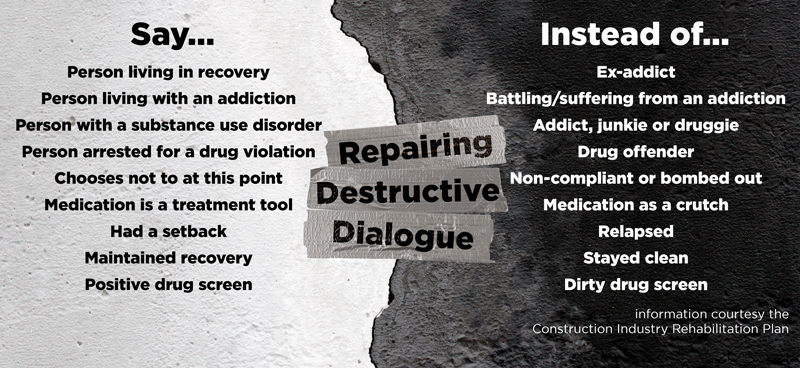Part one of Cracks in the Foundation: Mental Health, Substance Use and Construction, examines the current state of substance use across the country, with experts painting a picture of how the industry has been specifically impacted. The second article in this DCN-JOC Special Feature Series delves into the Ontario numbers and how some stark statistics have prompted industry action.
At least 57 construction workers died of overdoses in Ontario last year alone.
Fifty-seven.
The Ontario Drug Policy Research Network, the office of the Chief Coroner for Ontario and Public Health Ontario released a report in May stating 2,500 Ontarians died of drug overdoses in 2020, up from 1,500 in 2019, an increase of 60 per cent.
Of the victims who were employed, 30 per cent were construction workers, which was the most impacted industry by a wide margin.
What’s more, during the pandemic there has been a significant shift towards more opioid-related deaths among males. Specifically, 76 per cent of opioid-related deaths during the pandemic occurred among men, rising from 71 per cent of deaths during the pre-pandemic time period.
The highest rates of opioid-related death during the pandemic occurred in Sudbury and districts, Porcupine, and Algoma public health units, the report finds.
These statistics have spurred several industry stakeholders to take action, hoping in some way to encourage those living with addiction to seek help.
At the end of May, the Ontario Construction Consortium (OCC) launched the Other Pandemic campaign and the website TheOtherPandemic.ca, which brings together labour, management and owners to raise awareness about the opioid drug overdose crisis in the construction industry.
“When we were first planning this I was wondering if there would be some pushback from some people in the industry because it’s not a good news story but that just didn’t happen,” said Phil Gillies, executive director of the OCC.
“The overwhelming response was this had to be done and we’re really glad that the OCC and its partners went ahead and did it.”
The campaign included television, radio and print interviews and two full-page advertorials placed in major newspapers as well as a video featuring health experts and Toronto Mayor John Tory discussing the topic. A second video is now in the works.

“The OGCA (Ontario General Contractors Association) will be partnering with the OCC on a video about opioid use in construction to raise awareness about these issues,” said Erich Schmidt, manager of innovation and public affairs with the OGCA. “We have also been educating our members to ensure they are prepared in the event of an opioid-related issue onsite.”
When it launched, the campaign was supported by the Interior Systems Contractors Association, the Carpenters’ District Council of Ontario and the International Union of Painters and Allied Trades.
Other construction organizations have gotten on board since.
“We had emails and letters of support. The industry has been very supportive of what we’re trying to do.”
Richard Lyall, president of the Residential Construction Council of Ontario (RESCON), said substance use is closely connected with mental health.
“With the pandemic there are higher stress levels…opioid use has gone way up during the pandemic and that’s a real problem,” said Lyall. “There’s been an across-the-board increase in overdoses and substance use issues.
“The timing speaks for itself in that there has been a 60 per cent increase year-over-year in Ontario of opioid overdoses and deaths. That timing coincides with the pandemic.”
While the numbers for substance use are generally higher in construction, there are reasons that may not be apparent to everyone, said Lyall.
“It’s not because construction industry workers are less responsible, more likely to engage in risky behaviour,” he explained. “When you get that amount of physical activity there’s a pain element. They want a solution to pain because they want to keep working because they need an income.
“A big thing is awareness, people not ignoring the problem, having access to treatment and services and raising the question with people, just asking ‘are you OK,’ ” added Lyall.
It’s also important to recognize issues related to fit for duty, Schmidt said.
“Construction is a dangerous industry in relation to others. The risk of serious injury to the worker and to others onsite can significantly increase if an individual is not prepared for work due to mental stress, fatigue or impairment,” he said. “We are encouraging all of our members to establish control measures, including the implementation of a fit for duty policy, to prevent all aspects of impairment on construction projects.”
Patrick Dillon, chair of the De Novo Treatment Centre board of directors and business manager of the Provincial Building and Construction Trades Council of Ontario, said a research project is underway to identify the driving and triggering factors behind high addiction rates in the trades and to address them with training programs.
The De Novo Research Project, a partnership between the centre, the Provincial Building Trades Council of Ontario and the Ontario Erectors Association, is funded by the Ministry of Labour, Training and Skills Development. To collect the data, surveys were taken by members of the building trades unions and some former De Novo clients.
“We are doing a government funded research project to look at the causation factors,” said Dillon. “We’re trying to get a handle on that from the people who have been through it. Our intent is to put a training program together so that new entrants coming into the building trades we will be able to train them the same way we do with any other kind of safety.”
Follow the author on Twitter @DCN_Angela.
*The third article in part one of this special feature series, being released Sept. 9, will take a look at the situation in Western Canada and what some health experts are advising.











Recent Comments
comments for this post are closed